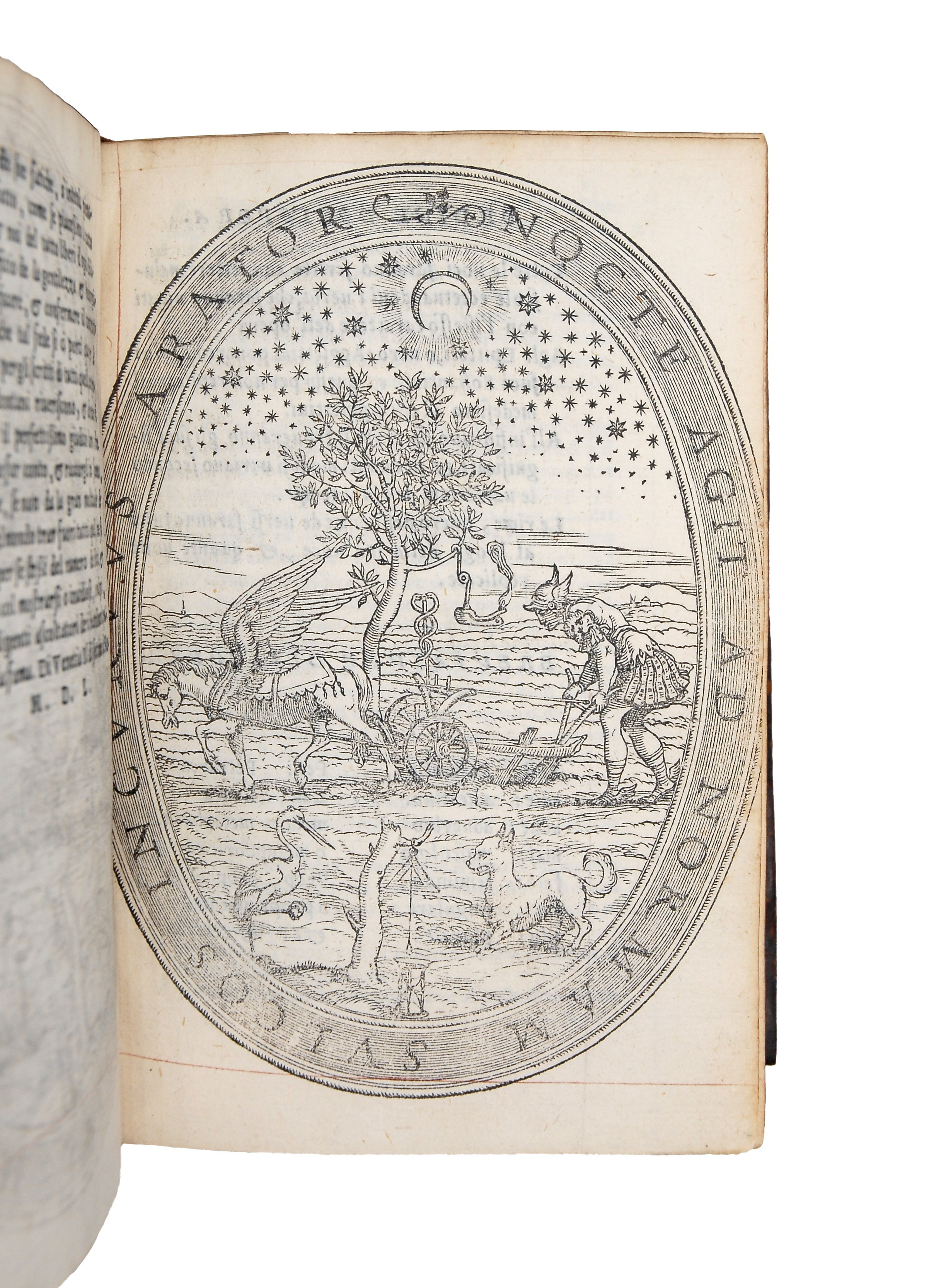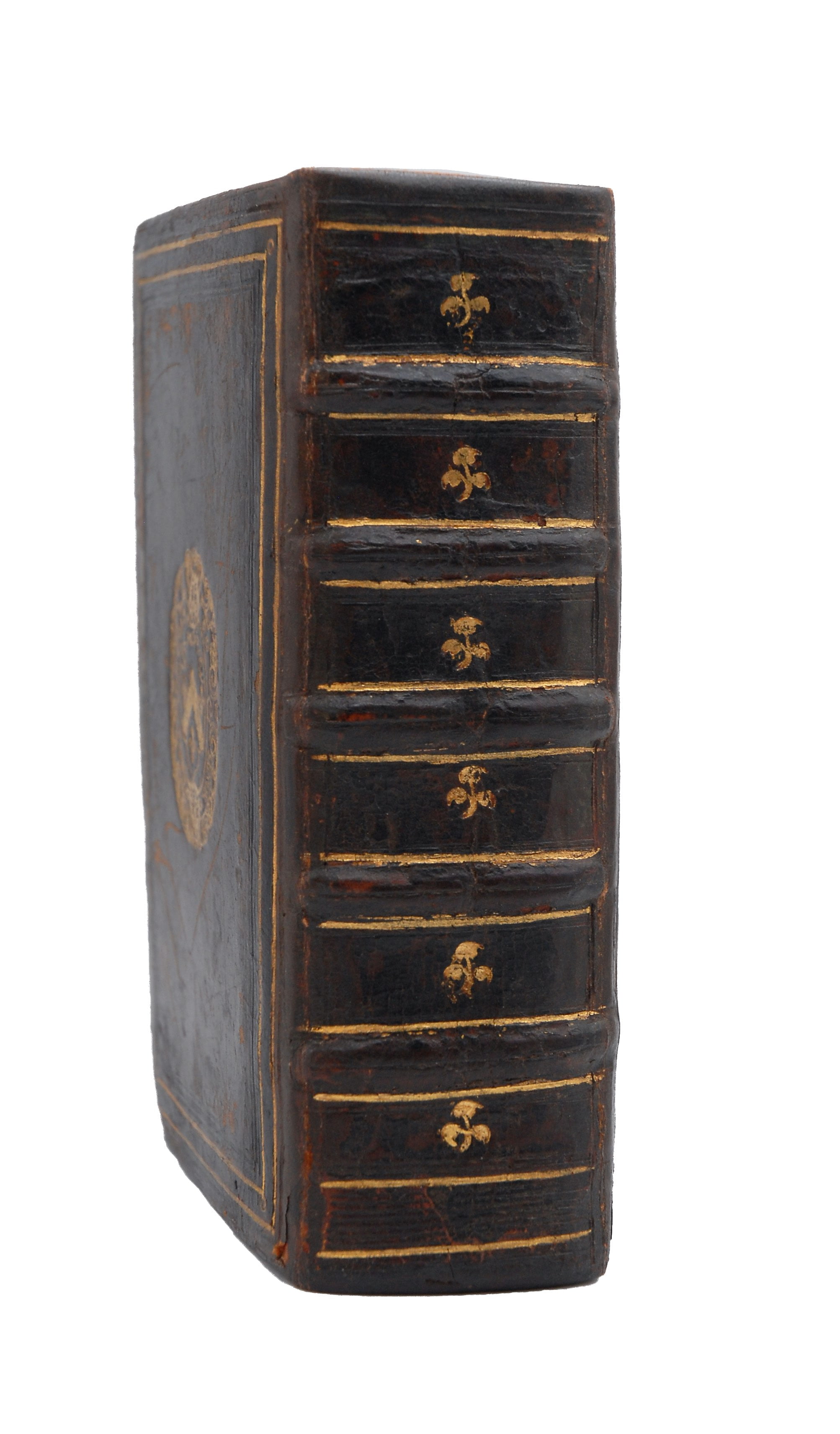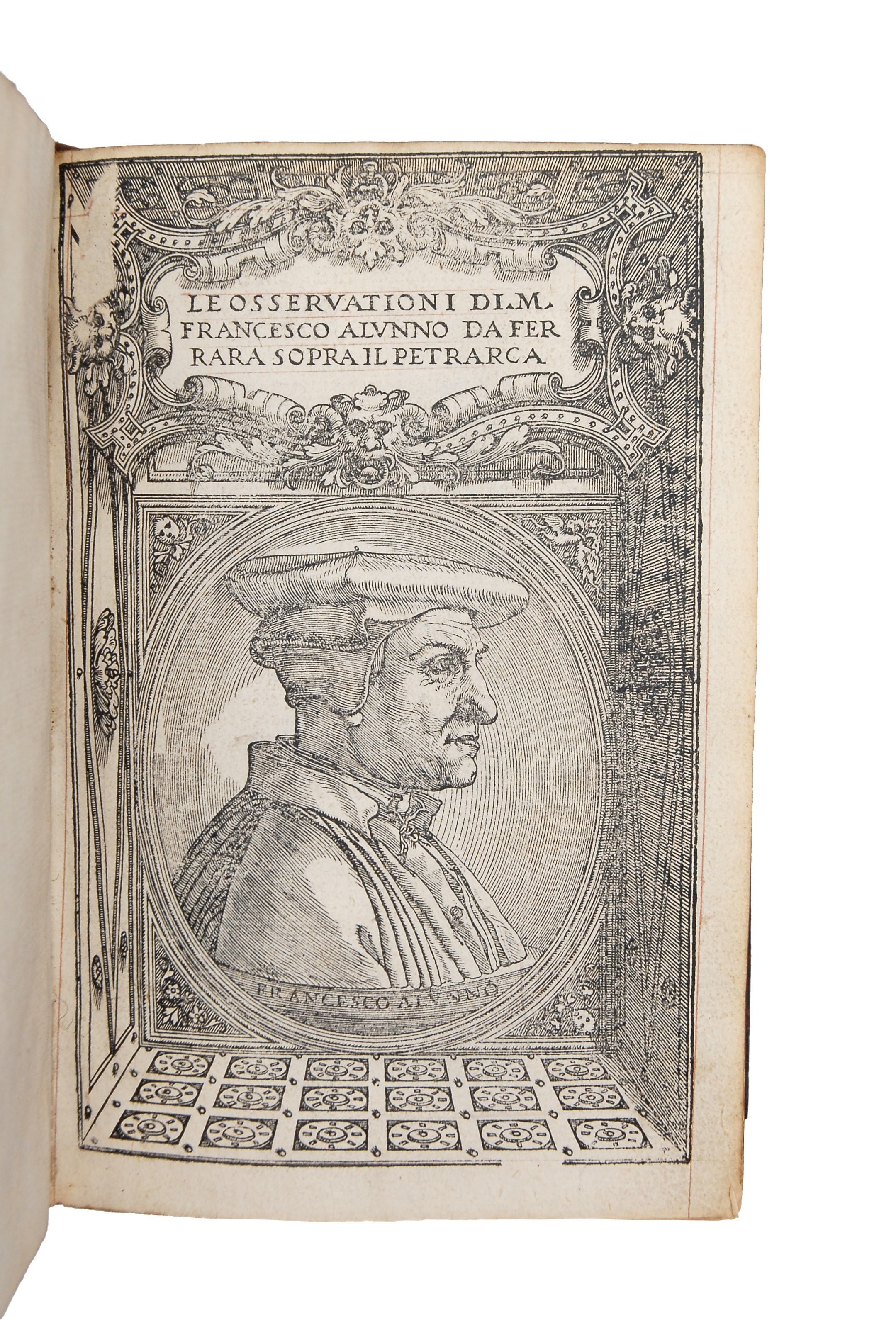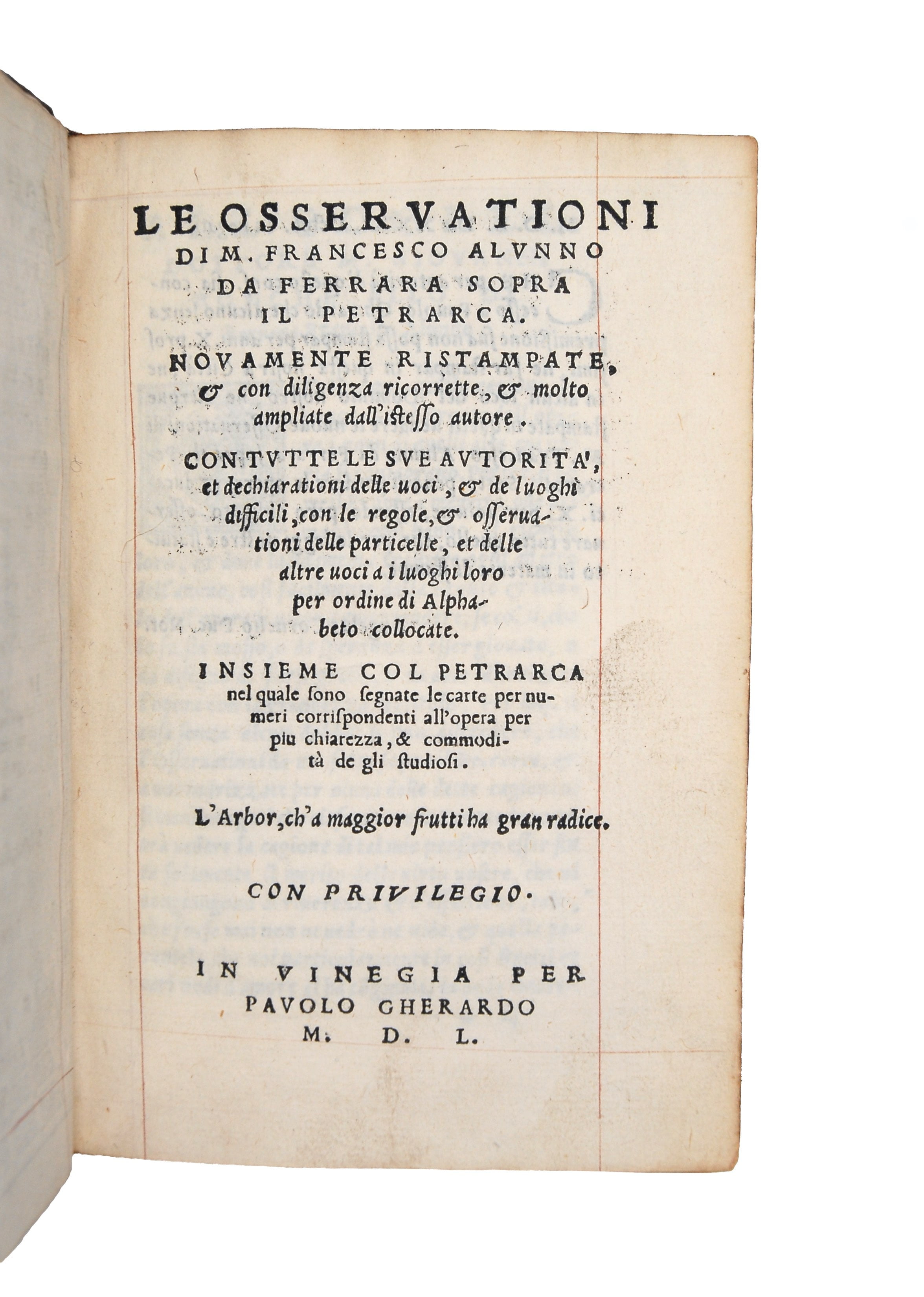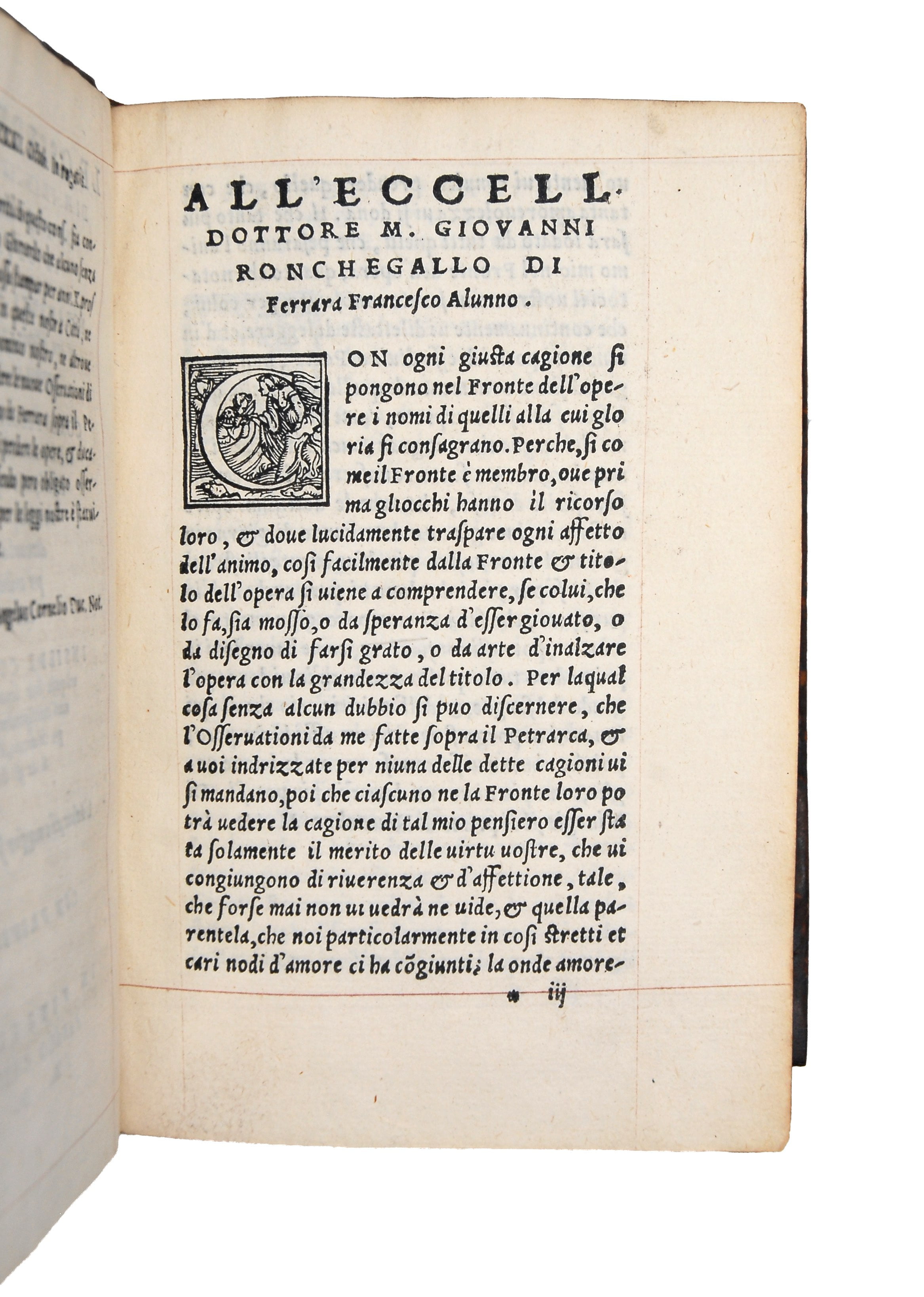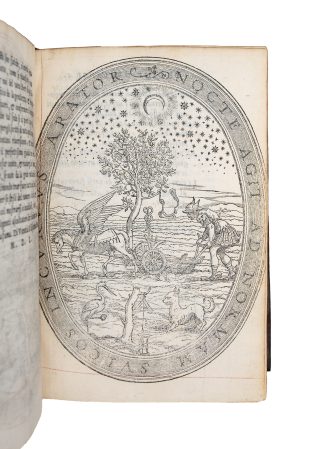ALUNNO, Francesco.
BOUND FOR SIR WILLIAM PICKERING FROM THE LIBRARY OF LORD CHESTERFIELD
Le osservationi di M. Francesco Alunno da Ferrara sopra il Petrarca
Venezia, Paolo Gherardo, 1550£13,500.00
8vo, ff. (viii) 527 (iii). Roman letter, some italic, text within fine red ink frame throughout. Woodcut historiated initials, handsome frontispiece with ornate cartouche at head and large portrait of author, full-page oval allegorical woodcut vignette surrounded by motto “Nocte agit ad normam sulcus incurvatus arator”. Tiny wormhole and wormtrail to lower outer blank corner of some final gatherings, small abrasion to . An excellent copy, crisp and clean in contemporary calf for Sir William Pickering (1516 – 1575), covers double gilt and blind ruled with Pickering’s arms in gilt at centres, a few minor scratches to lower, spine with blind and gilt ruled raised bands, gilt leafy tools in compartments, joints skillfully repaired, a.e.g. C18 bookplate of Philip Dormer Stanhope (1694-1773), 4th Earl of Chesterfield and modern bookplate of the Argentine lawyer and collector Eduardo J. Bullrich (1895-1951) to front paste-down. In folding box.
Attractive second edition, improved and enlarged, of Alunno’s important concordance of Petrarch’s vocabulary, handsomely bound for the English diplomat and bibliophile Sir William Pickering (1516 – 1575). Pickering was “Knight Marshal to Henry VIII (…) He was educated at Cambridge. In 1539 he was a Gentleman in Waiting to Henry VIII and is said to have served in the war at Calais. He was knighted at the coronation of Edward VI, and sent on a special embassy to France in 1551. Later that year he returned to Paris as a permanent Ambassador, being recalled a month after Mary’s accession in 1553. Involved in plots against the Spanish marriage, he found it prudent to travel in Italy and Germany, returning in 1555. Elizabeth employed him as her ambassador to the Netherlands and Germany in 1558 1559, and he was even mentioned as a possible husband for the Queen.” (BAB, Pickering, William, Sir). Pickering was a noted collector with a particular taste for Italian books – these constitute the majority of his surviving library – many of which he probably acquired during a trip to Venice in the 1550s.
Francesco Alunno (or De Bailo, 1485-1556) was an Italian grammarian and writer of Ferrara. While working as a teacher of arithmetic and calligraphy in Udine and then in Venice, Alunno composed and published a series of impressive lexicographic works, culminating in his “La fabbrica del mondo” a comprehensive vocabulary of Petrarch, Dante, Boccaccio and other Italian writers. “Le osservationi sopra il Petrarca”, first published in 1539, is Alunno’s first work. A vast glossary of Petrarchan words in alphabetical order, ‘Le osservationi’ provides definitions for each word or difficult expression, a quotation from Petrarch showing its use in context, advice on when to use different spellings, and page reference numbers to the printed edition of Petrarch’s works published by Gherardo the same year. This second edition was considerably enriched with more entries and corrected in many places by the author. Also added are a few of letters attesting to Alunno’s relations with Venetian writers and printers (e.g. Girolamo Ruscelli), as well as an entertaining fictitious epistolary exchange between Petrarch and the author, with Petrarch’s letter at the beginning and Alunno’s response at the end of the work.
The woodcut portrait of the author was employed for various works by Alunno and designed for the first edition of ‘Le osservationi’; for this edition, the cartouche title was recut. The beautiful full-page allegorical woodcut depicts Mercury, bent over a plow pulled by Pegasus by the light of an oil lamp suspended from the branch of a laurel tree. In the foreground, a dog and a crane stand at the sides of a dry trunk. This enigmatic image, which only appears in a handful of books, has been identified as the mark or emblem of the venetian printer Marcantonio Magno (c. 1480-1549), which was then adopted by Paolo Gherardo after Magno’s death.
Remarkably, not all books from Pickering’s library had armorial bindings, and “most of the surviving books have the armorial stamps in a strangely mutilated state, in which the hurts [roundels] have been scratched from the chevron and the resulting gaps have been filled with liquid gold” (BAB). The binding of this copy is beautifully preserved, with the original gilt stamp (BAB, Stamp 3) in clean and clear impression.
Philip Dormer Stanhope (1694-1773) was a British statesman, diplomat and man of letters. He is “chiefly remembered as the author of Letters to His Son and Letters to His Godson — guides to manners, the art of pleasing, and the art of worldly success. (…) Chesterfield’s winning manners, urbanity, and wit were praised by many of his leading contemporaries, and he was on familiar terms with Alexander Pope, John Gay, and Voltaire. He was the patron of many struggling authors but had unfortunate relations with one of them, Samuel Johnson, who condemned him in a famous letter (1755) attacking patrons. Johnson further damaged Chesterfield’s reputation when he described the Letters as teaching “the morals of a whore, and the manners of a dancing master.” Dickens later caricatured him as Sir John Chester in Barnaby Rudge (1841)” (Encyclopaedia Britannica).
USTC 762205; EDIT16 CNCE 25767; Adams A841; BM STC It. C16 p. 504. See Brunet IV, p. 550; Graesse V, p. 226-7; Harvard It 18. BAB = British Armorial Bindings Database, ‘Pickering, William, Sir, (1516 -1575)’. See National Portrait Gallery, NPG D33066.In stock


